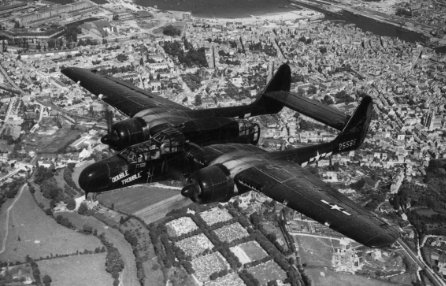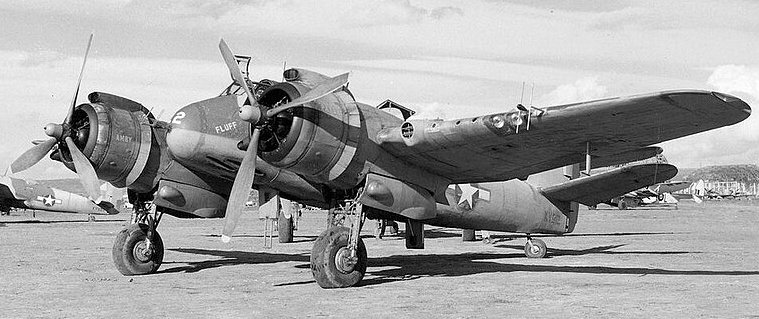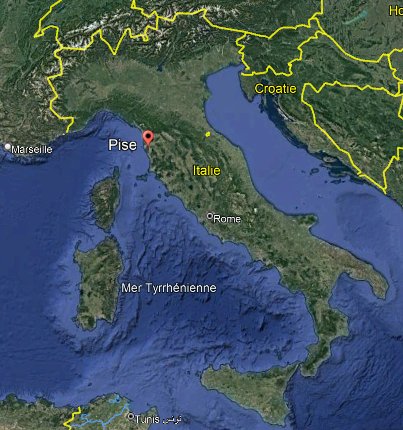ACUFO-1945-02-16-PISA-1
In a 2009 catalog of sightings of “Foo-Fighters” during World War II, ufologist Dominique Weinstein noted a case from the 2007 book “Strange Company - Military Encounters with UFOs in World War II” by Keith Chester, the latter having indicated that the source of the report was an operations report of the 414th Night Fighter Squadron of the U.S. Army Air Forces for February 15-16, 1945, which can be found in the U.S. National Archives.
The summary, rather confused, says that during this mission on the night of February 15-16, 194, between Pisa and Pontedera, or over Livorno and Pontedera, Italy, Lieutenant Shaffer, pilot, and Lieutenant Ayres, his radar operator, were conducting a patrol aboard their P-61B “Black Widow.”
At 01:30 a.m., they were at 15,000 feet, near the Pisa air base, when they spotted and flew over a “flare.” About ten minutes later another “flare” appeared between Pisa and Pontedera, and ten minutes later they observed a third “flare” which “appeared to be spiraling” in the vicinity of Pisa. It said:
“The flares were observed to burn at 6,000 feet, then disappear under the overcast sky.” A few minutes later, the crew “saw a spurt of flame, which went out immediately just West to Viareggio.” They had observed the flame between 10,000 and 13,000 feet high. The pilot had prepared to chase the flares, then saw two more spurts of flame but “couldn't get any contact”, as his P-61 flew at 290 mph, reaching 400 mph during the dive.
The crew felt like they were chasing a jet plane for fifty miles in a straight line over the sea, before losing it in the clouds.
| Date: | February 16, 1945 |
|---|---|
| Time: | 01:30 a.m. |
| Duration: | Minutes. |
| First known report date: | February 16, 1945 |
| Reporting delay: | Hours. |
| Country: | Italy |
|---|---|
| State/Department: | Tuscany |
| City or place: | Pisa |
| Number of alleged witnesses: | 2 |
|---|---|
| Number of known witnesses: | ? |
| Number of named witnesses: | 2 |
| Reporting channel: | Military operations report, UFO book Keith Chester. |
|---|---|
| Visibility conditions: | Night. |
| UFO observed: | Yes. |
| UFO arrival observed: | ? |
| UFO departure observed: | Yes. |
| UFO action: | None, spiraling. |
| Witnesses action: | Attempt intercept. |
| Photographs: | No. |
| Sketch(s) by witness(es): | No. |
| Sketch(es) approved by witness(es): | No. |
| Witness(es) feelings: | ? |
| Witnesses interpretation: | Flares and 1 jet plane. |
| Sensors: |
[X] Visual: 2
[ ] Airborne radar: Not reported. [ ] Directional ground radar: Not reported. [ ] Height finder ground radar: [ ] Photo: [ ] Film/video: [ ] EM Effects: [ ] Failures: [ ] Damages: |
|---|---|
| Hynek: | NL |
| Armed / unarmed: | Armed, 4 Hispano 20 mm cannons, 4 Browning M2 12.7 mm machine guns. |
| Reliability 1-3: | 2 |
| Strangeness 1-3: | 1 |
| ACUFO: | Probable flares, one enemy plane. |
[Ref. dwn2:] DOMINIQUE WEINSTEIN:
Pilot Lt Shaffer and radar operator Lt Ayres conducted a patrolling on their P-61 B Black Widow ( 414th NFS) over Leghorn and Pontedera. At 1 h30, they were at 15,000 feet, close to Pisa Air Base, when they spotted and circled “a flare”. About ten minutes later, another “flare” appeared between Pisa and Pontedera, and ten minutes after that, they observed a third “flare” that “seemed to spiral” in the vicinity of Pisa. “The flares were observed to burn at 6,000 feet then disappeared below overcast.” Then again, within minutes, the crew “saw a spurt of flame, which went out immediately just West to Viareggio.” They observed the flame between an altitude of ten and thirteen thousand feet. The pilot prepared to chase the flares and then saw two more spurts of flame but was unable to obtain a contact (the Black Widow was 290 mph, reaching 400 mph on the dive). The crew felt they were chasing a jet-propelled aircraft for fifty miles on a straight course right out over the sea, before loosing it in the clouds.
Sources: 414th NFS Daily Operations Report, 15/16 February, 1945, NARA / Strange Company, Keith Chester, 2007
(Ref. nip1:) "THE NICAP WEBSITE":
Feb. 15/16, 1945; Pisa, Italy
Multiple sightings: flare; flare that seemed to spiral. (Page 136 Ref.1)
The reference 1 is described at the end of the document as “Strange Company (2007), Keith Chester”.
[Ref. tai1:] "THINK ABOUT IT" WEBSITE:
Date: Feb. 15/16, 1945
Location: Pisa, Italy
Time:
Summary: Multiple sightings: flare; flare that seemed to spiral.
Source:
The Northrop P-61 “Black Widow” was a high performance american night fighter plane used in WWII.
It was twin-engined, with a maximum speed of 589 km/h, 3,060 km range. The crew was of three men.
It was equipped with an onboard radar set and armed with 4 Hispano 20 mm cannons in the fuselage and 4 Browning M2 12.7 mm machine guns in the remotely controlled upper turret.

|
The Bristol Type 156 “Beaufighter”, nicknamed “Beau”, was a British multi-role aircraft developed during World War II. It was originally designed as a heavy fighter variant of the Bristol Beaufort torpedo bomber; it proved to be an effective night fighter, which entered service with the Royal Air Force (RAF) during the Battle of Britain.
Originally the armament consisted of four 20 mm cannons and six 0.303 inch machine guns, but many variants were built; for example, versions had the capacity to additionally carry eight rocket projectiles, some had a Vickers 'K' cannon, the Beaufighter TF.Mk X was used for anti-shipping operations.
Like the P-61, the Beaufighters in night fighter versions were equipped with on-board radar.

|

|
In 1992, when discovering “Foo-Fighters” reports of another unit, the 415th Night Fighter Squadron, in the U.S. National Archive, US ufologist Barry Greenwood made some comments that vary much appluy here:
“... mission reports tended to be brief in their descriptions of everything. There were reports of aircraft destroyed, buildings bombed, flak, vehicles destroyed; etc. Then, scattered amongst the information, were reports of strange lights in the sky.”
And:
“One frustrating feature of these reports is their brevity. It is difficult to form a hypothesis on the origin of Foo-Fighters when such fragmentary information is available. It is sometimes hard to tell whether reports of “lights” by the pilots were in the air or on the ground so one should exercise caution when reading reports where this is not clear.”
In this case, I may add that there is no sign at all that the airmen considered what they reported to be something out of the ordinary. When they did, in other cases, they talked of “Foo Fighters”, “Foo Fires” œ “phenomena”. On the contrary, here, they talk of flares.
In one instance, they reported a spiraling light. This happens with malfunctioning flares.
Obviously, several different sightings are mixed in one case here, the full report being unavailable to me so far, it is indeed hard to understand each even separately.
We are told that the crew of 2 was flying a P-61B “Black Widow”. I have a doubt about this. First, the “Black Widow” had a crew of 3. Second, the 414th Night Fighter Squadron was at that time transitioning from British-built Bristol Beaufighters to U.S.-built “Black Widows”, and were still using the Beaufighters; which had a crew of 2.
In several such cases, it is my impression that ufologists decided the plane was a P-61, although the aircraft type was generally not indicated in the reports. In some such cases, the error can be clearly seen.
Whether the plane was a Beaufighter or a “Black Widow”, it was equipped with AI (i.e., Airborne Intercept radar, onboard radar.) Also, those missions were aided by “GCI” (Ground Control Intercept, is, a radar station on the ground radioing the plane about targets they detected. But in this report, we get no information about any radar track. Of course, flares would normally not appear on radar screens.
My overall assessment of this case is that this crew reported about flares, with the exception of the mention of a jet plane at the end of the report.
Probable flares, one enemy plane.
* = Source is available to me.
? = Source I am told about but could not get so far. Help needed.
| Main author: | Patrick Gross |
|---|---|
| Contributors: | None |
| Reviewers: | None |
| Editor: | Patrick Gross |
| Version: | Create/changed by: | Date: | Description: |
|---|---|---|---|
| 0.1 | Patrick Gross | December 24, 2023 | Creation, [dwn2], [nip1], [tai1]. |
| 1.0 | Patrick Gross | December 24, 2023 | First published. |